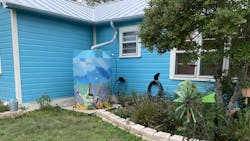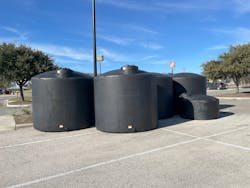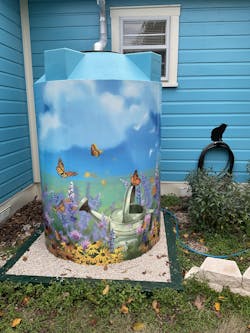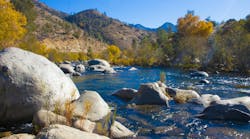With water conservation and rainwater collection hot topics for areas experiencing drought, a new twist was explored in San Marcos, Texas recently. Two city programs were combined to install a small rainwater collection system and wrap it with artwork to make it attractive and functional. This story describes the programs used, the issue with drought in the area, and the effect rainwater collection can have if scaled up to reduce drinking water demands for outdoor water use.
Process
The City of San Marcos Public Services Conservation Program provides rebates to individuals and businesses for installing rainwater capture cisterns. The program coordinator encourages businesses and residents of San Marcos to apply for rebates on these collection systems that includes the tank, gutters and pumping equipment for small and large size systems. These systems reduce runoff of rainwater to the city’s storm drain system while also saving water to use onsite for landscape, flushing toilets, and if treated additionally, even for drinking water. In any case, use of rainwater instead of potable water can reduce the demand on the city’s drinking water system.
Also, the San Marcos Convention and Visitors Bureau has a program in place to beautify the city’s traffic control boxes with colorful art-inspired wraps. The wrap is a tightly adhering heavy duty vinyl film that can be digitally printed with custom or stock artwork. In San Marcos, the city program has installed over ___ wraps through a contract with a local graphic arts company.
Although cisterns are becoming more available in various hardware stores, feedstores, etc., they are relatively neutral to uninspiring for a lawn or business front (Photo 1). To save water and beautify a space, one resident applicant added a colorful wrap to their cistern. A digital artist, and alumni of the local High School, was commissioned to design the artwork. The resident provided the artist with ideas and example images, and the artist created a unique piece. The artist and graphic arts company coordinated on the piece to establish size criteria and overlap requirements for the wrap. The artwork was sent electronically to the graphic arts company where it was printed and installed on the cistern. The results were transformational as shown in Photos 1 and 3. This fully functioning cistern is now also an extension of color, flowers and sunlight to a native plant bed that had a shady, muddy corner.
For residential use, artwork can encourage more residents to join into the rainwater collection effort as it does not add an unattractive feature, but rather one that can be personalized.
It was important that the cistern have a smooth surface with no texture for optimal wrap adhesion. Plastic tanks and metal tanks are ideal as well as corrugated metal tanks with a smooth surface added around a portion of the tank for the wrap.
Drought
This past summer, severe drought in Central Texas caused the City of San Marcos to implement strict water restrictions that limited outdoor watering to once every two weeks. Many homeowners and businesses use drought tolerant plants and grasses, but even these decline with limited watering. The National Weather Service website states that as of January 4, 2024, 24% of the Hill Country in Central Texas remains in severe drought conditions. The local groundwater aquifer is at its lowest level since the 1950s.
Texas, like other parts of the country, has been in drought for the last two summers, and it is not expected to improve in the foreseeable future. Added to the rainfall shortage is the increased demand for potable water from increased population growth in this area. According to civil engineering design standards, each person has a water demand of about 80-100 gallons per day. New residents cannot be turned away, so capturing rainwater gives relief to both water supply issues and plant needs. Native, flowering plants provide food and shelter to pollinators. These plants thrive on rainwater since it lacks chlorine added to potable drinking water.
Large warehouse style businesses such as film studios, manufacturing plants, distribution centers, and grocery stores are being built along with the growth of population. These facilities have large metal roofs that are ideal for rainwater capture. The larger capture areas lead to larger runoff volumes and can have a greater impact on drought relief. Commercial buildings can add LEED points to their green building efforts, help meet sustainability goals, and conserve water use by using collected rainwater to irrigate their drought tolerant landscape.
For commercial-size cisterns, the addition of artwork in the form of logos, inspirational messaging, company vision or beautiful images, can enhance the industries’ use of the cisterns and their image within the city. Businesses that reduce their potable water demand through water conservation measures and rainwater collection and reuse efforts, are showing good neighbor characteristics in an area where water is becoming an increasingly limiting resource.
Drain the rain
The U.S. Environmental Protection Agency (EPA) and local water authorities promote the idea to not only collect the rain, but to use it. The concept of “drain the rain” is to use as much of the collected water as possible before the next rain event, so the tank has the capacity to capture another volume of rain. Landscape personnel and residents should be mindful of the next rainfall events and keep watering schedules that nourish the plants and grass and drain the tank to the landscape prior to the next rainfall. Keeping the cistern full does not meet the goal of rainwater capture and reuse. This takes effort and planning and should be a part of a regular use and maintenance program for the cistern.
Scale up
Wraps on cisterns are durable and will provide beauty to areas needing color and creativity. In a town the size of San Marcos (about 60,000 people), if 5% of the population installed a 500-gallon cistern, it would provide a capacity to catch 1.5 million gallons of water. Drinking water saved would be enough to provide 14 homes with a family of three for drinking water for a year based on the average per person water demand. These savings would be realized each time the 500-gallon tanks were filled.
In the example shown in Photos 1 and 3, the runoff area of roof is about 200 square feet and the 500-gallon cistern will be filled after 2 inches of rain. This can occur in one rain event or with the accumulation of several smaller rains. Larger tanks with capacities of 2000-10,000-gallon tanks generally work with much larger roof areas, can exhibit larger art images/messages, and provide more drought relief to outdoor landscapes.
Scale up of rainwater capture is needed to make a difference with the ongoing drought, to keep our native plants alive during drought, and to reduce the demand on local drinking water supplies. Municipalities and counties offering rainwater collection programs may consider funding artwork in the cistern rebate to boost participation among commercial and residential end users. Neighborhood Beautification Programs within municipalities may join the efforts with funding. Grants are available for beautifying cities and promoting water conservation from many different funding sources.
In both literature and art, water is considered the universal symbol for change — it is forever flowing and can take any course. As drought prevails and water becomes scarcer, perhaps the stormwater solution to more rainwater collection is art — the common denominator of society and catalyst for change.
About the Author
Lisa Arceneaux
P.E., CISEC, CPESC
Lisa Arceneaux is P.E., CISEC, CPESC at EAEnvironmental Co. Arceneaux can be reached at [email protected].




